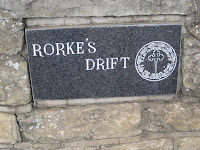 |
| Gravesite near our Ladysmith home |
Since arriving in South Africa I have taken
a very keen interest in this country’s history. It started when Chris and I
discovered three grave markers in our local neighborhood that marked the
resting place of three soldiers who served and died in Ladysmith during the
English-Boar war. Two of them were
serving with the 5th Lancers, an Irish contingent, which was one of
many units who fought during this war around 1900.
With the help of local historian, John
Hawkesbury, we discovered that one of the soldiers, PTE F. Dowsett, actually drowned in the Klip
River that runs behind and below our current boarding, the other died of
shrapnel wounds. The third I know little about except that he was curator of
graves and died about 10 years after the other two.
 I digress. My purpose in writing this is to
describe our trip to Rorke’s Drift, organized by Mr. Hawkesbury and the
Ladysmith Historical Society.
I digress. My purpose in writing this is to
describe our trip to Rorke’s Drift, organized by Mr. Hawkesbury and the
Ladysmith Historical Society.
The
battle, or defense of Rorke’s Drift, took place, Wednesday
22 and Thursday 23 January, 1879, when some 150 mainly British soldiers
defended a supply station against some 4000 Zulus. This defense was brought to
the attention of the world through the movie Zulu, starring Michael Cane. It is
a remarkably accurate depiction of the events or those two days with some
embellishments. This movie is still available on Netflix.
 |
| Museum display of soldiers and their defensive position |
 |
| Elder and Sister Brown |
Mr. Hawkesbury, a retired British army officer, arranged this trip on
our preparation day and invited our local missionaries and the Browns, our good
friends from Newcastle, to join us. There were also about 30 other people from
Ladysmith, mainly members of the historical society.
 |
| John and Charles, X British officers |
Our host at the site was another retired British officer, Charles
Aikenhead, who owns a hotel at the site. This hotel overlooks the Buffalo River
which played a prominent part in the event. Mr. Aikenhead, and Mr. Hawkesbury,
and the president of the society, took turns guiding us around the area and
explaining the history of the event.
Briefly, because many of you may have or will see this movie, I will
give an only a few details.
On January 22, 1879, a British army unit that was encamped at Isandhlwana about 15k
from Rorke’s Drift was attacked by 20,000 Zulu warriors. It was a great defeat
for the British and they lost about 1700 men. This incident was the “British
Alamo” according to our guides.
 |
| Viewing the Isandhlwana site with our group |
The Zulu’s had about 4000 additional warriors
that were not involved in the battle because they were younger men that were
ordered to remain in reserve. When they saw what happened and that they could
have no part in the spoils of war, they decided that they would take it upon
themselves to attack the supply depot at Rorke’s Drift. The Drift was only
being held by 150 soldiers and it looked easy for the taking.
There are a lot of details and information that I could share, but I
won’t do that here. For those of you who are interested, Google will direct you
and the movie Zulu will be quite educational and interesting.
This site is only about 50 miles from where we live, about a 2-hour
drive due to a long stretch of dirt road.
 |
| John with a Martini-Henry rifle |
Our hosts were wonderful. They led us to various sites and explained the
history, showed us the Martini-Henry rifles that the British used to defend
themselves, took us to the actual site of the battle and explained how these
150 soldiers held off 4000 warriors before reinforcements arrived. At Rorke's Drift, eleven Victoria Crosses were awarded. Seven to the 2nd Battalion, 24th (2nd Warwickshire) Regiment of Foot, one to the Army Medical Department, one to the Royal Engineers, one to the Commissariat and Transport Department and one to the Natal Native Contingent.
 |
| Reconstructed hospital |
We viewed the exhibit in the museum, the memorials to both the British
and the Zulu warriors, and generally enjoyed the whole experience.
I was a little disappointed to discover that
the way the battle ended in the movie, was not what really happened. It ended
because the “cavalry arrived” at the last moment!
We sometimes undertake excursions like this
to give us a little break from the other six very busy days of serving the
Lord. It fires us up and enables us to continue on in His service.
Plus, it
helps to give us a better understanding of the people of South Africa and how
they got to where they are today. And we
don’t take sides...go Brits, go Zulu’s, go Boers! Did you know that Ghandi served here in
Ladysmith during the Anglo-Boer war? Or that Winston Churchill was here as a
war correspondent during that same war? And he was actually captured by the Boers?
 |
| At the hotel overlooking the Buffalo River. Don't we look relaxed! |
Stay tuned!



No comments:
Post a Comment